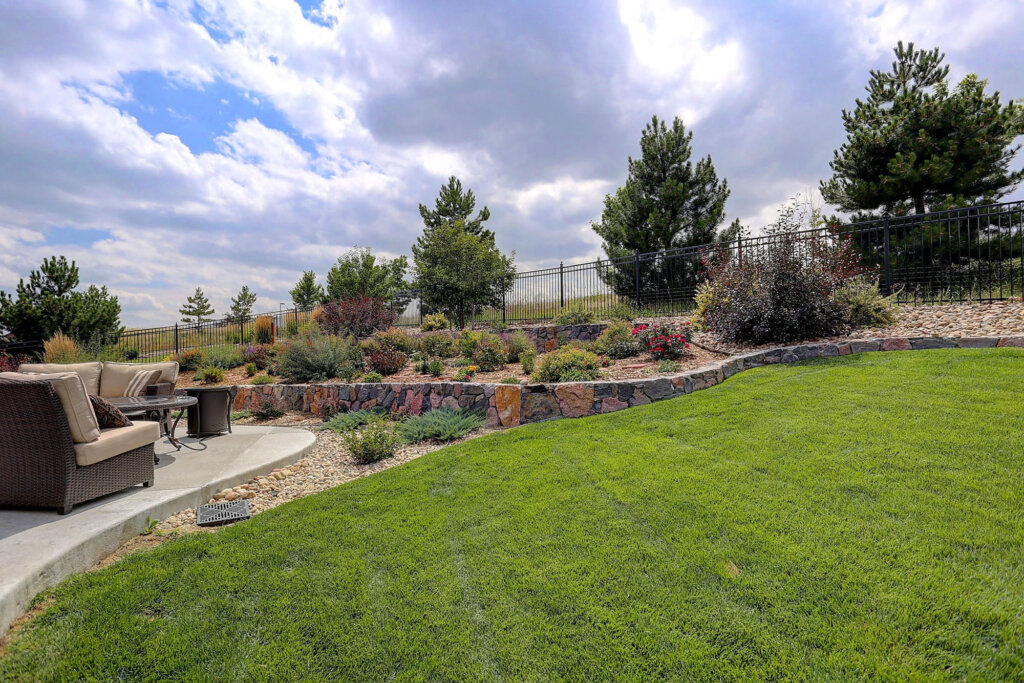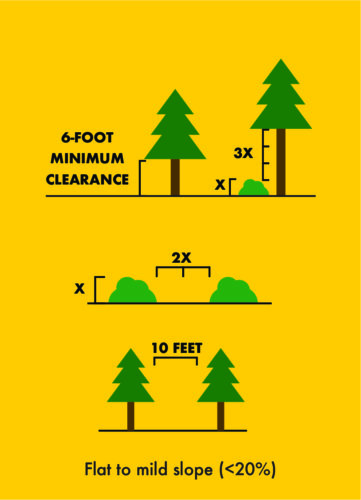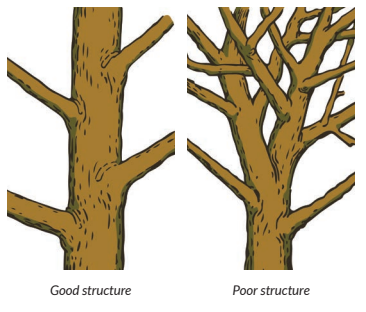Fire-Smart Landscaping
Help prevent the spread of wildfires with fire-smart landscaping practices.

What is fire-smart landscaping?
Developing a fire-smart landscape goes beyond just maintaining a neat yard. It involves choosing and placing fire-resistant plants that thrive in California’s dry climate. Fire-smart landscaping is cost-effective too, as it conserves water and can increase your property value.
For tailored advice on fire-resistant plants perfect for your area, check with local nurseries, landscape contractors, or your county’s UC Cooperative Extension service. They can guide you in creating an effective, affordable fire-smart landscape.
Landscaping tips
Choosing the right plants and caring for them properly can make your garden more resistant to wildfires. This quick guide will cover how to pick, place, and maintain plants to help protect your home.
Not all ‘fire-safe’ plants are created equal. Even though some plants are labeled as ‘fire-safe’ or ‘fire-resistant’, their actual risk of burning can vary greatly depending on care and environmental conditions. Here’s what you need to know:
- Environment matters: A plant’s surroundings and how it’s cared for play a big role in its flammability.
- Watering makes a difference: Well-watered plants tend to be less flammable, holding onto their leaves longer and maintaining a healthier growth.
- Stress increases risk: Plants under stress from drought or poor conditions may become more flammable due to stunted growth and dead material buildup.
- Growth changes over time: Plants like lavender can change from lush and green to woody and flammable as they age.
- Watch for thatch: Some plants can develop a layer of dead material under their green surface, which can catch fire easily.
- Vertical clearance is key: Always make sure there’s enough space between the ground and the lower branches to reduce fire risk.

Choosing plants based on ‘fire-safe’ labels can be tricky. Here’s why you should look beyond the label:
- Inconsistent testing: Research by Bethke et al. (2016) found that plant flammability tests lack standardization, making ‘fire-safe’ claims unreliable.
- Confusing definitions: The terms used in flammability testing can vary, leading to confusion.
- Care & region matter: How a plant is cared for and where it grows can affect its fire resistance more than its label.
- Focus on plant traits: Consider a plant’s specific characteristics, like moisture content and growth rate, and how well it fits into your garden’s environment instead of relying solely on ‘fire-safe’ ratings.
The way you maintain a plant can impact its wildfire risk more than its species. Here are key plant traits to consider when choosing plants with fire prevention in mind:
- Moisture content: Opt for plants with leaves that retain moisture, as they’re less likely to catch fire.
- Waxes & oils: Plants high in waxes, oils, and resins can be more flammable.
- Growth structure: Open-growth plants may have lower fire risk than dense ones.
- Growth speed: Fast-growing plants need more space and maintenance.
- Height potential: Know how tall a plant can get to ensure it fits your space.
- Shedding habits: Plants that shed bark or leaves need frequent cleanup to reduce fire hazards.
- Flammability & location: Place high-resin plants away from your home to minimize fire risk.
- Ember traps: Dense plants near your home can trap embers; choose wisely.
- Cleanup is crucial: Regularly remove fallen leaves and branches, especially near structures.
- Defensible space: Fast-growing or large-leafed plants might need extra attention to fit within your fire safety plan and maintain a defensible space.
- Plant choice diversity: While native, pollinator-friendly, and drought-tolerant plants are great, their fire resistance can vary.
Choosing the right location for your plants is key to enhancing your home’s defense against wildfires:
- Avoid direct contact: Don’t let plants touch your home’s siding, windows, eaves, vents, or decks to minimize fire risks.
- 0-5 feet zone: Keep this area next to structures clear of combustible plants and materials to prevent ember ignition and direct flame contact.
Proper care of your garden’s vegetation can significantly improve its resistance to wildfires:
- Water & fertilize wisely: Good watering habits and appropriate fertilization keep plants healthy and less prone to fires.
- Regular pruning & cleanup: Keeping your plants trimmed and your garden tidy reduces fire risks.
- Drip irrigation & mulching: Use drip irrigation for efficient watering and choose non-combustible mulch like rock to prevent fire hazards near your home.
- Avoid combustible mulches: Combustible mulches near the home create an additional fire risk (Quarles & Smith, 2008). Keep flammable mulches away from your home’s foundation to reduce the risk of ember ignition.
- Compost as a safer alternative: Mixing compost into the soil around plants is a less flammable option than combustible mulches.
Aging plants and pruning:
- Manage shedding: Regularly remove fallen leaves and branches, especially from aging plants, to prevent them from becoming fire fuel.
- Open structure pruning: Create an open growth structure through pruning to prevent fire from climbing plants.
- Height management: Keep an eye on plant height and prune as needed to maintain a manageable size and reduce fire spread potential.
- Pruning techniques: Apply proper pruning methods to train young trees from the start, including at planting, to ensure healthy and fire-resistant growth.

Shade trees offer valuable benefits but require careful management to enhance fire safety:
- Shade & cooling: Trees provide natural cooling and protection from solar radiation.
- Tree health: Regularly assess tree health and remove or replace those that are diseased or in decline to keep your property safe.
- Risks of overhanging branches: Branches close to or overhanging buildings can damage structures and increase fire risk by dropping debris on roofs, gutters, and decks.
- Fire safety measures:
- Remove any branches that overhang roofs or decks to prevent fire spread and physical damage.
- Maintain a healthy tree canopy, which is less likely to catch embers.
- Position trees at least 5 feet from structures, prune lower limbs, and clear away dead materials to prevent fire from climbing.
Useful resources for fire-smart landscaping
- California Invasive Plant Council Landscaping Guidelines
- Safe Landscapes in the Wildland-Urban Interface
- Tree Care Information from International Society of Arboriculture
- Landscaping for Wildfire Preparation and Recovery
- SelectTree: A Tree Selection Guide
- Invasive Weeds Awareness – California Native Plant Society
References
Quarles, S. and Smith E. 2008. The Combustibility of Landscape Mulches. University of Nevada Cooperative Education Publication SP-11-04. Reno, NV.
Bethke, J., Bell, C., Gonzales, J., Lima, L., Long, A., and MacDonald, C. 2016. UCCE San Diego. Research Literature Review of Plant Flammability Testing, Fire-Resistant Plant Lists and Relevance of a Plant Flammability Key for Ornamental Landscape Plants in the Western States.